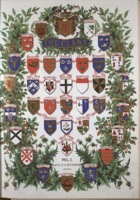Difference between revisions of "Clan"
m (Text replacement - "http://nordan.daynal.org" to "https://nordan.daynal.org") |
m (Text replacement - "http://" to "https://") |
||
| Line 3: | Line 3: | ||
==Etymology== | ==Etymology== | ||
[https://nordan.daynal.org/wiki/index.php?title=English#ca._1100-1500_.09THE_MIDDLE_ENGLISH_PERIOD Middle English], from Scottish Gaelic clann offspring, clan, from Old Irish cland plant, offspring, from [[Latin]] planta plant | [https://nordan.daynal.org/wiki/index.php?title=English#ca._1100-1500_.09THE_MIDDLE_ENGLISH_PERIOD Middle English], from Scottish Gaelic clann offspring, clan, from Old Irish cland plant, offspring, from [[Latin]] planta plant | ||
| − | *Date: [ | + | *Date: [https://www.wikipedia.org/wiki/15th_Century 15th century] |
==Definitions== | ==Definitions== | ||
*1 a : a [[Celtic]] [[group]] especially in the Scottish Highlands comprising a number of households whose heads claim [[descent]] from a common [[ancestor]] | *1 a : a [[Celtic]] [[group]] especially in the Scottish Highlands comprising a number of households whose heads claim [[descent]] from a common [[ancestor]] | ||
| Line 13: | Line 13: | ||
==Description== | ==Description== | ||
| − | A '''clan''' is a [[group]] of people [[united]] by [[actual]] or [[perceived]] kinship and [[descent]]. Even if [[actual]] lineage [[patterns]] are [[unknown]], clan members may nonetheless recognize a founding member or [ | + | A '''clan''' is a [[group]] of people [[united]] by [[actual]] or [[perceived]] kinship and [[descent]]. Even if [[actual]] lineage [[patterns]] are [[unknown]], clan members may nonetheless recognize a founding member or [https://en.wikipedia.org/wiki/Apical_ancestor apical ancestor]. The kinship-based bonds may be merely [[symbolical]] in [[nature]], whereby the clan [[shares]] a "stipulated" common ancestor that is a symbol of the clan's [[unity]]. When this ancestor is not [[human]], it is referred to as an animalian [https://en.wikipedia.org/wiki/Totem totem]. Clans can be most easily described as [[tribes]] or sub-groups of tribes. The word clan is derived from 'clann' meaning '[[children]]' in the Irish and Scottish [https://en.wikipedia.org/wiki/Gaelic_language Gaelic languages]. The word was taken into [[English]] about 1425 as a label for the tribal [[nature]] of Irish and Scottish Gaelic society. The Gaelic term for clan is fine [finɨ]. Clans are located in every country; members may identify with a coat of arms to show they are an [[independent]] clan. |
==Organization of clans in anthropology== | ==Organization of clans in anthropology== | ||
| − | Some clans are [ | + | Some clans are [https://en.wikipedia.org/wiki/Patrilineality patrilineal], meaning its members are related through the [[male]] line; for example, the clans of Armenia. Others are [https://en.wikipedia.org/wiki/Matrilineality matrilineal]; its members are related through the [[female]] line, such as in some [https://en.wikipedia.org/wiki/Indigenous_peoples_of_the_Americas Native American clans]. Still other clans are bilateral, consisting of all the descendants of the [https://en.wikipedia.org/wiki/Apical_ancestor apical ancestor] through both the [[male]] and [[female]] lines; the Irish and Scottish clans are examples. Another example is the Jewish people defined mainly as the clan of descendants of one male ancestor (Jacob) and four female ancestors (Leah, Rachel, Bilhah and Zilpah). Whether a clan is patrilineal, matrilineal, or bilateral depends on the kinship rules and [[norms]] of their [[society]]. |
| − | Clans in [[indigenous]] [[societies]] are likely to be [ | + | Clans in [[indigenous]] [[societies]] are likely to be [https://en.wikipedia.org/wiki/Exogamy exogamous], meaning that their members cannot marry one another. In some [[societies]], clans may have an official leader such as a chieftain or patriarch; in others, [[leadership]] positions may have to be [[achieved]], or people may say that 'elders' make [[decisions]]. |
==See also== | ==See also== | ||
*'''''[[Tribe]]''''' | *'''''[[Tribe]]''''' | ||
[[Category: Anthropology]] | [[Category: Anthropology]] | ||
Latest revision as of 23:45, 12 December 2020
Etymology
Middle English, from Scottish Gaelic clann offspring, clan, from Old Irish cland plant, offspring, from Latin planta plant
- Date: 15th century
Definitions
- 1 a : a Celtic group especially in the Scottish Highlands comprising a number of households whose heads claim descent from a common ancestor
- 2 : a group united by a common interest or common characteristics
Description
A clan is a group of people united by actual or perceived kinship and descent. Even if actual lineage patterns are unknown, clan members may nonetheless recognize a founding member or apical ancestor. The kinship-based bonds may be merely symbolical in nature, whereby the clan shares a "stipulated" common ancestor that is a symbol of the clan's unity. When this ancestor is not human, it is referred to as an animalian totem. Clans can be most easily described as tribes or sub-groups of tribes. The word clan is derived from 'clann' meaning 'children' in the Irish and Scottish Gaelic languages. The word was taken into English about 1425 as a label for the tribal nature of Irish and Scottish Gaelic society. The Gaelic term for clan is fine [finɨ]. Clans are located in every country; members may identify with a coat of arms to show they are an independent clan.
Organization of clans in anthropology
Some clans are patrilineal, meaning its members are related through the male line; for example, the clans of Armenia. Others are matrilineal; its members are related through the female line, such as in some Native American clans. Still other clans are bilateral, consisting of all the descendants of the apical ancestor through both the male and female lines; the Irish and Scottish clans are examples. Another example is the Jewish people defined mainly as the clan of descendants of one male ancestor (Jacob) and four female ancestors (Leah, Rachel, Bilhah and Zilpah). Whether a clan is patrilineal, matrilineal, or bilateral depends on the kinship rules and norms of their society.
Clans in indigenous societies are likely to be exogamous, meaning that their members cannot marry one another. In some societies, clans may have an official leader such as a chieftain or patriarch; in others, leadership positions may have to be achieved, or people may say that 'elders' make decisions.
